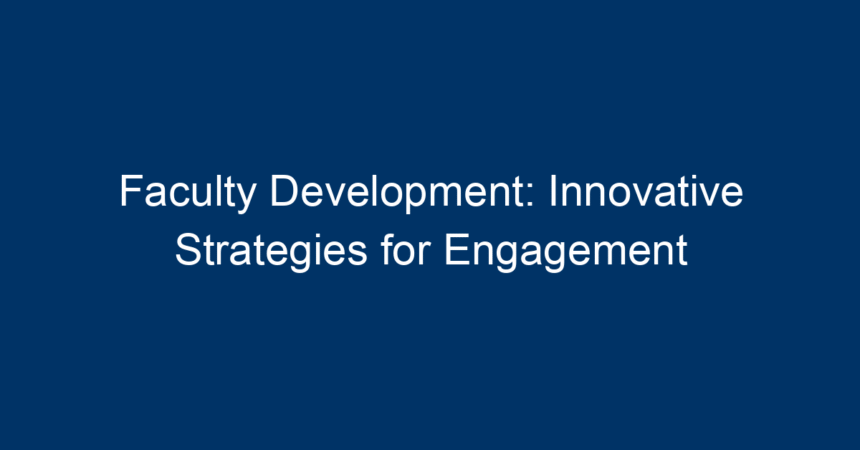Introduction
In today’s rapidly evolving educational landscape, faculty development has become integral to institutional success and teaching effectiveness. As educators grapple with new technologies, diverse student needs, and shifting pedagogical methodologies, innovative strategies for engagement are more crucial than ever. This article explores various approaches to enhancing faculty development, fostering collaboration, and promoting an engaging learning environment for both instructors and students.
The Importance of Faculty Development
Enhancing Teaching Quality
Faculty development plays a pivotal role in improving instruction quality. Educators who engage in professional development continuously refine their teaching methods, which leads to better student engagement and improved performance. Furthermore, ongoing training ensures faculty stay abreast of emerging trends and methodologies, which is essential in a world where educational practices are in constant flux.
Fostering a Collaborative Culture
Faculty development initiatives foster collaboration among educators. By creating opportunities for faculty to share insights and strategies, institutions can cultivate a supportive atmosphere that enhances teaching and learning. Collaborations lead to innovation; sharing successful practices encourages faculty members to adopt new ideas and adapt their teaching styles accordingly.
Innovative Strategies for Engagement
1. Peer Mentoring Programs
A robust mentoring program pairs experienced faculty with newer educators, facilitating knowledge transfer and fostering professional relationships. Mentors can provide feedback, share resources, and offer emotional support, creating a culture of continuous improvement within the institution. Implementing structured peer mentoring not only aids in professional development but also enhances job satisfaction and retention rates among faculty.
Benefits:
- Encourages open communication
- Builds invaluable relationships
- Increases confidence among new faculty
2. Technology Integration Workshops
As technology continues to transform education, faculty must become adept at leveraging digital tools. Hands-on workshops that explore innovative technologies—such as learning management systems, collaborative platforms, and interactive teaching methods—can significantly elevate faculty engagement. By embedding these tools into the curriculum, educators can enhance both their teaching and students’ learning experiences.
Benefits:
- Prepares faculty for contemporary teaching challenges
- Boosts student engagement through interactive content
- Encourages the adoption of best practices
3. Flexible Professional Development Opportunities
Recognizing that every faculty member has different needs and schedules, institutions should offer a variety of professional development formats. Options might include asynchronous online courses, short interactive workshops, and on-demand resources. By providing flexible options, faculty can engage in development opportunities at their own pace, leading to higher participation rates.
Benefits:
- Accommodates diverse learning styles
- Increases participation in faculty development activities
- Offers personalized learning experiences
4. Interdisciplinary Collaboration
Encouraging cross-disciplinary collaborations can be a powerful driver of faculty engagement. By forming interdisciplinary teams to work on shared projects or curricular innovations, faculty can leverage diverse expertise and perspectives. This not only broadens knowledge but also fosters creativity and innovation.
Benefits:
- Breaks down silos within departments
- Fosters new ideas and perspectives
- Encourages holistic problem-solving
5. Regular Feedback Mechanisms
Creating a culture of feedback is essential for faculty development. Regularly soliciting input from faculty allows institutions to adapt their development programs to meet the evolving needs of educators. Anonymous surveys, focus groups, and one-on-one meetings can yield valuable insights that inform future initiatives.
Benefits:
- Continuously improves faculty development programs
- Engages faculty in the decision-making process
- Increases satisfaction and ownership of development efforts
Creating an Inclusive Environment
Understanding Diverse Needs
Engaging faculty from various backgrounds requires an understanding of their diverse needs. Inclusive faculty development programs take into account factors such as teaching experience, disciplinary context, and individual goals. Tailoring programs to address these aspects increases engagement and effectiveness.
Encouraging Open Dialogue
Establishing platforms for open dialogue about teaching practices can enhance engagement within the faculty. Forums, workshops, and symposiums that encourage sharing teachable moments and challenges experienced in the classroom promote a sense of community and shared learning.
Enhancing Faculty Development Through Recognition
Celebrating Achievements
Recognizing faculty’s efforts and achievements in professional development can significantly boost morale and motivation. Institutions should celebrate milestones—such as completing a professional development course or implementing successful teaching strategies—through awards, public acknowledgments, or features in newsletters.
Benefits:
- Encourages continuous participation in faculty development
- Fosters a culture of appreciation
- Boosts faculty morale and engagement
Actionable Insights for Faculty Development
-
Implement Regular Assessment: Regularly evaluate faculty development programs to ensure they meet the evolving needs of educators.
-
Encourage Experimentation: Provide a safe space for faculty to experiment with new teaching methods without fear of failure.
-
Facilitate Networking Opportunities: Organize events that encourage faculty to network with colleagues, both within and outside their departments.
-
Cultivate Leadership Skills: Offer workshops that develop leadership skills among faculty, preparing them for future roles within the institution.
- Incorporate Student Feedback: Integrate student evaluations into faculty development strategies, using them to inform faculty training and resource allocation.
Conclusion
Innovative faculty development strategies are essential for creating an engaging and effective teaching environment. By emphasizing collaborative mentorship, technology integration, and inclusive practices, institutions can foster a culture of continuous development. As educational challenges evolve, so too must faculty development initiatives. By ensuring that our educators are well-equipped, supported, and engaged, we ultimately enhance the educational experiences for all students, paving the way for future success.
By implementing these actionable insights and strategies, institutions can take significant steps toward enriching their faculty’s development journey, ensuring that both educators and students thrive in a dynamic learning landscape.




